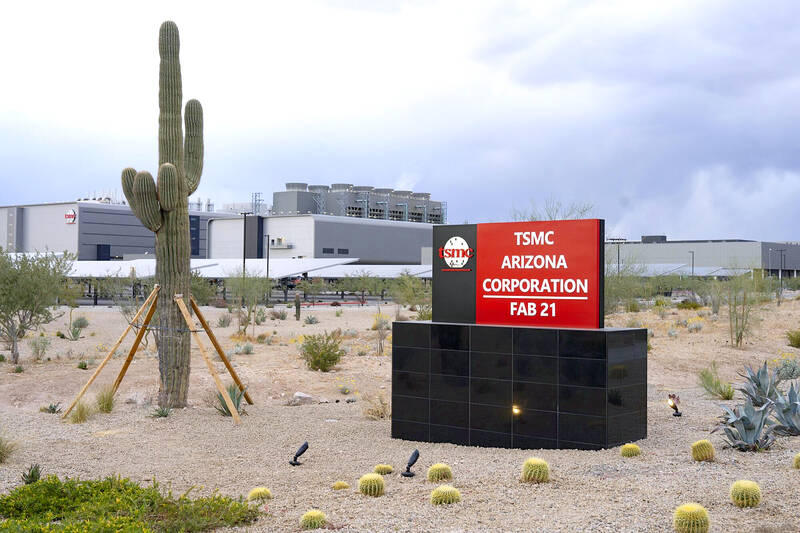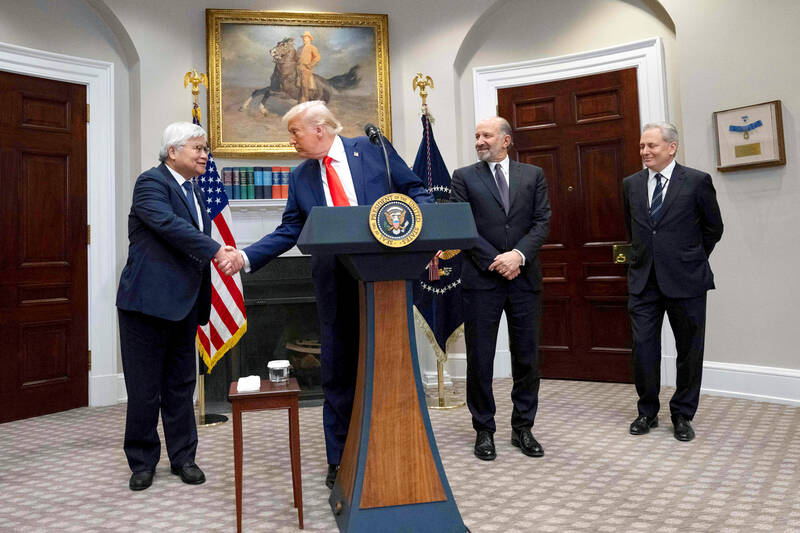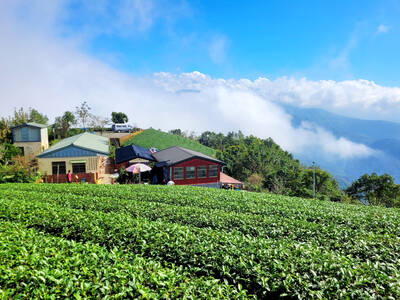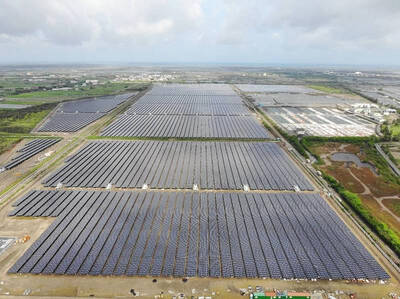Taiwanese chip-making giant Taiwan Semiconductor Manufacturing Co (TSMC) plans to invest a whopping US$100 billion in the US, after US President Donald Trump threatened to slap tariffs on overseas-made chips.
TSMC is the world’s biggest maker of the critical technology that has become the lifeblood of the global economy.
This week’s announcement takes the total amount TSMC has pledged to invest in the US to US$165 billion, which the company says is the “largest single foreign direct investment in US history.”

Photo: Bloomberg
It follows Trump’s accusations that Taiwan stole the US chip industry and his threats to impose tariffs of up to 100 percent — and Taipei’s promises to invest more in the US.
The following is a look at what TSMC’s investment could mean for Taiwan.
‘SILICON SHIELD’

Photo: AFP
Semiconductor chips are used in everything from smartphones and televisions to electric vehicles and missiles — and more than half of them are made in Taiwan.
The concentration of chip manufacturing has long been seen as a “silicon shield” protecting the country from an invasion or blockade by China — and an incentive for the US to defend it.
China has upped military pressure on Taiwan in recent years to press its unfounded claim of sovereignty over the country, where TSMC has its headquarters and the bulk of its fabrication plants.
That has fueled calls for the firm to move more of its production out of the country to avoid supply disruptions if China did attack. Trump recently warned of import levies of 25 percent, or higher, on overseas-made chips, which one analyst has said could trigger a recession in the industry.
While TSMC’s latest investment might deflect the threat of tariffs, there are fears it could hurt Taiwan’s economy and weaken its “silicon shield.”
“The more TSMC produces in the United States, the less important Taiwan will be in geopolitics and the less incentives the United States will have to help Taiwan in the future,” said Ko Ju-chun (葛如鈞), a lawmaker with the main opposition Chinese Nationalist Party.
CONTROL OF TSMC
Taiwan’s leaders are aware of the risks as they try to stay onside with their most important security backer Washington and protect the nation’s status as a chip-making powerhouse.
President William Lai (賴清德) office said Tuesday the government would review TSMC’s deal “in accordance with the law” and ensure that the “most advanced” chip-making processes stayed in Taiwan.
TSMC had already pledged to invest more than US$65 billion in three factories in the US state of Arizona, one of which began production late last year. The US$100 billion investment will be used to expand its US footprint further, with three new fabrication plants, two advanced packaging facilities and a research and development team center.
Richard Hu (胡瑞舟), deputy director of the Taiwan Center for Security Studies think tank, said Trump wanted to prevent TSMC from falling into China’s hands and to make it a “technological asset of the United States.”
“Trump’s ultimate goal is to ensure that the US can fully or critically control TSMC’s semiconductor production, making it a de facto part of America’s chip industry,” Hu said.
DEFENSE GUARANTEES
Taipei security analyst Su Tzu-yun (蘇紫雲) was more optimistic, saying that TSMC’s investment would make Taiwan “safer” and help grow the chip industry.
It would also build trust between Taipei and Washington, and ease Trump’s concerns about US economic security, said Su, from the Institute for National Defense and Security Research.
“I think the importance of Taiwan is not only TSMC but also the geostrategy,” Su said, noting the importance of global shipping lanes near Taiwan.
However, James Yifan Chen of Tamkang University said higher manufacturing costs in the US would drive up prices of products using TSMC chips.
And there were no guarantees the investment would make the mercurial Trump more inclined to defend Taiwan.
“The deal’s effect on US willingness to defend Taiwan is unclear,” said Sung Wen-Ti (宋文笛), a nonresident fellow with the Atlantic Council’s Global China Hub.
“It really depends on how Trump feels on any particular day, and whether Beijing will attempt to outbid Taiwan subsequently.”

In recent weeks the Trump Administration has been demanding that Taiwan transfer half of its chip manufacturing to the US. In an interview with NewsNation, US Secretary of Commerce Howard Lutnick said that the US would need 50 percent of domestic chip production to protect Taiwan. He stated, discussing Taiwan’s chip production: “My argument to them was, well, if you have 95 percent, how am I gonna get it to protect you? You’re going to put it on a plane? You’re going to put it on a boat?” The stench of the Trump Administration’s mafia-style notions of “protection” was strong

Every now and then, it’s nice to just point somewhere on a map and head out with no plan. In Taiwan, where convenience reigns, food options are plentiful and people are generally friendly and helpful, this type of trip is that much easier to pull off. One day last November, a spur-of-the-moment day hike in the hills of Chiayi County turned into a surprisingly memorable experience that impressed on me once again how fortunate we all are to call this island home. The scenery I walked through that day — a mix of forest and farms reaching up into the clouds

With one week left until election day, the drama is high in the race for the Chinese Nationalist Party (KMT) chair. The race is still potentially wide open between the three frontrunners. The most accurate poll is done by Apollo Survey & Research Co (艾普羅民調公司), which was conducted a week and a half ago with two-thirds of the respondents party members, who are the only ones eligible to vote. For details on the candidates, check the Oct. 4 edition of this column, “A look at the KMT chair candidates” on page 12. The popular frontrunner was 56-year-old Cheng Li-wun (鄭麗文)

“How China Threatens to Force Taiwan Into a Total Blackout” screamed a Wall Street Journal (WSJ) headline last week, yet another of the endless clickbait examples of the energy threat via blockade that doesn’t exist. Since the headline is recycled, I will recycle the rebuttal: once industrial power demand collapses (there’s a blockade so trade is gone, remember?) “a handful of shops and factories could run for months on coal and renewables, as Ko Yun-ling (柯昀伶) and Chao Chia-wei (趙家緯) pointed out in a piece at Taiwan Insight earlier this year.” Sadly, the existence of these facts will not stop the